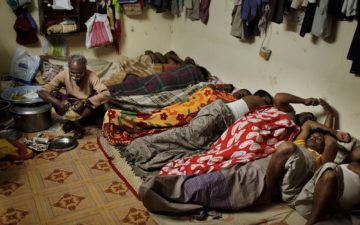Bernard Freamon in Aeon:
 The six city-states on the Arab side of the Persian Gulf, each formerly a sleepy, pristine fishing village, are now all glitzy and futuristic wonderlands. In each of these city-states one finds large tracts of ultramodern architecture, gleaming skyscrapers, world-class air-conditioned retail markets and malls, buzzing highways, giant, busy and efficient airports and seaports, luxury tourist attractions, game parks, children’s playgrounds, museums, gorgeous beachfront hotels and vast, opulent villas housing fabulously affluent denizens. The six city-states – Dubai and Abu Dhabi in the United Arab Emirates (UAE), Manama in Bahrain, Dammam in Saudi Arabia, Doha in Qatar, and Kuwait City in Kuwait – grew into these luminous metropolises beginning in the 1970s, fuelled by the discovery of oil and gas, an oligarchic accumulation of wealth, and unconditional grants of political independence from the United Kingdom, the former colonial master of the region. Thereafter, the family-run polities that took control of these city-states began to attract huge amounts of financial capital from all over the world. Abu Dhabi, the capital of the UAE, has been described as ‘the richest city in the world’, with wealth rivalling that seen in Singapore, Hong Kong or Shanghai. Like those cities, Abu Dhabi is swimming in over-the-top affluence. According to a 2007 report in Fortune magazine, Abu Dhabi’s 420,000 citizens, who ‘sit on one-tenth of the planet’s oil and have almost $1 trillion invested abroad, are worth about $17 million apiece’.
The six city-states on the Arab side of the Persian Gulf, each formerly a sleepy, pristine fishing village, are now all glitzy and futuristic wonderlands. In each of these city-states one finds large tracts of ultramodern architecture, gleaming skyscrapers, world-class air-conditioned retail markets and malls, buzzing highways, giant, busy and efficient airports and seaports, luxury tourist attractions, game parks, children’s playgrounds, museums, gorgeous beachfront hotels and vast, opulent villas housing fabulously affluent denizens. The six city-states – Dubai and Abu Dhabi in the United Arab Emirates (UAE), Manama in Bahrain, Dammam in Saudi Arabia, Doha in Qatar, and Kuwait City in Kuwait – grew into these luminous metropolises beginning in the 1970s, fuelled by the discovery of oil and gas, an oligarchic accumulation of wealth, and unconditional grants of political independence from the United Kingdom, the former colonial master of the region. Thereafter, the family-run polities that took control of these city-states began to attract huge amounts of financial capital from all over the world. Abu Dhabi, the capital of the UAE, has been described as ‘the richest city in the world’, with wealth rivalling that seen in Singapore, Hong Kong or Shanghai. Like those cities, Abu Dhabi is swimming in over-the-top affluence. According to a 2007 report in Fortune magazine, Abu Dhabi’s 420,000 citizens, who ‘sit on one-tenth of the planet’s oil and have almost $1 trillion invested abroad, are worth about $17 million apiece’.
More here.
